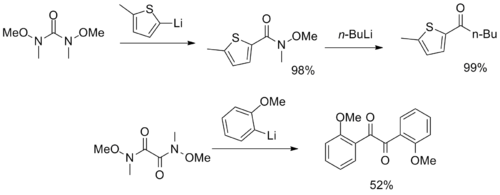Weinreb ketone synthesis
| Weinreb ketone synthesis | |
|---|---|
| Named after | Steven M. Weinreb |
| Reaction type | Coupling reaction |
| Identifiers | |
| Organic Chemistry Portal | weinreb-ketone-synthesis |
The Weinreb ketone synthesis or Weinreb–Nahm ketone synthesis is a chemical reaction used in

The major advantage of this method over addition of organometallic reagents to more typical acyl compounds is that it avoids the common problem of over-addition. For these latter reactions, two equivalents of the incoming group add to form an alcohol rather than a ketone or aldehyde. This occurs even if the equivalents of nucleophile are closely controlled.

The Weinreb–Nahm amide has since been adopted into regular use by organic chemists as a dependable method for the synthesis of ketones. These functional groups are present in a large number of natural products and can be reliably reacted to form new carbon–carbon bonds or converted into other functional groups. This method has been used in a number of syntheses, including macrosphelides A and B,[2] amphidinolide J,[3] and spirofungins A and B.[4]
Mechanism
Weinreb and Nahm originally proposed the following

This chelation is in contrast to the mechanism for formation of the over-addition product wherein collapse of the tetrahedral intermediate allows a second addition. The mechanistic conjecture on the part of Weinreb was immediately accepted by the academic community, but it was not until 2006 that it was confirmed by spectroscopic and kinetic analyses.[5]
Preparation
In addition to the original procedure shown above (which may have compatibility issues for sensitive substrates), Weinreb amides can be synthesized from a variety of
Treatment of an ester or lactone with AlMe3 or AlMe2Cl affords the corresponding Weinreb amide in good yields. Alternatively, non-nucleophilic Grignard reagents such as isopropyl magnesium chloride can be used to activate the amine before addition of the ester.[7]

A variety of peptide coupling reagents can also be used to prepare Weinreb–Nahm amides from carboxylic acids. Various carbodiimide-, hydroxybenzotriazole-, and triphenylphosphine-based couplings have been reported specifically for this purpose.[6][7]

Finally, an aminocarbonylation reaction reported by Stephen Buchwald allows conversion of

Scope
The standard conditions for the Weinreb–Nahm ketone synthesis are known to tolerate a wide variety of functional groups elsewhere in the molecule, including alpha-halogen substitution, N-protected

Nonetheless, the Weinreb–Nahm amide figures prominently into many syntheses, serving as an important coupling partner for various fragments. Shown below are key steps involving Weinreb amides in the synthesis of several natural products, including members of the

Variations
Reaction of Weinreb–Nahm amides with Wittig reagents has been performed to avoid the sometimes harsh conditions required for addition of hydride reagents or organometallic compounds. This yields an N-methyl-N-methoxy-enamine that converts to the corresponding ketone or aldehyde upon hydrolytic workup.[10]

Additionally, a one-pot magnesium–halogen exchange with subsequent arylation has been developed, showcasing the stability of the Weinreb–Nahm amide and providing an operationally simple method for the synthesis of aryl ketones.[11]

More unusual reagents with multiple Weinreb–Nahm amide functional groups have been synthesized, serving as CO2 and α-diketone synthons.[12][13]

Finally, Stephen G. Davies of Oxford has designed a chiral auxiliary that combines the functionality of the Weinreb amide with that of the Myers' pseudoephedrine auxiliary, allowing diastereoselective enolate alkylation followed by facile cleavage to the corresponding enantioenriched aldehyde or ketone.[14]

